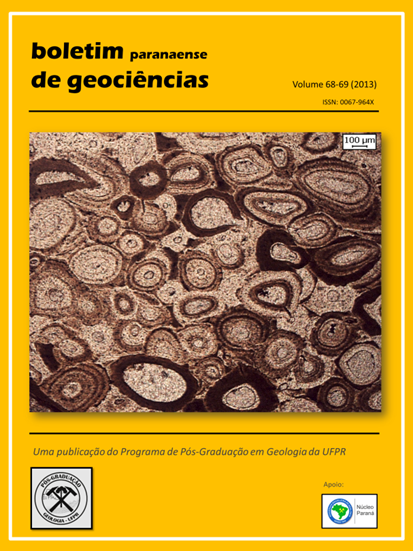TAPHONOMIC ASPECTS OF VERTEBRATE FOSSILS FROM BAURU GROUP, UPPER CRETACEOUS, BRAZIL
DOI:
https://doi.org/10.5380/geo.v69i0.30235Keywords:
Bauru Group, taphonomy, vertebratesAbstract
The Bauru Basin covers an area of about 370.000 km2, occurring in São Paulo, Paraná, Mato Grosso, Mato Grosso do Sul, Minas Gerais and Goiás states in Brazil, and also in the northeast of Paraguay. These upper Cretaceous sequence correspond to a semi-arid to arid climate and is divided in two groups, Bauru and Caiuá. The first one has the major record of fossils, being the focus of the taphonomic study. Field trips to Marília and Monte Alto municipalities (São Paulo State) and also to Uberaba city (Minas Gerais State) were made to check the depositional context and collect fossiliferous material. Vertebrate collections were visited, as the Museu de Paleontologia from Marília and Monte Alto (SP), Museu de Paleontologia da Universidade de São Paulo, as well as Museu dos Dinossauros, Centro de Pesquisas Paleontológicas Llewellyn Ivor Price from Peirópolis (MG). Four biostratinomic classes related to articulated/disarticulated fossils were identified in Vale do Rio Peixe, Uberaba, Marília, São José do Rio Preto and Presidente Prudente formations. Class I represents articulated and almost complete specimens, corresponding mainly to turtles and crocodiles. Class II comprises partially articulated specimens of skull and jaw fossils, or sequences of vertebrae. Classes I and II were recorded in Vale do Rio do Peixe, Marília (Serra da Galga Member) and Presidente Prudente formations. Class III is represented by isolated bones, and Class IV by fragmented bones. These two last classes appear in all units of the basin. For diagenetic analysis, 19 thin sections were made showing that, in general, the bone structure is well preserved, with spatic calcite filling the bone and the presence of the original phosphatic material. Marília Formation, on Echaporã Member, is the most different unit of the basin, being more carbonatic. The study of thin sections, considering the osseous structure and the biostratinomic analysis, match with the paleoenvironmental contextualization.
Downloads
Published
How to Cite
Issue
Section
License
Direitos Autorais para artigos publicados nesta revista são do autor, com direitos de primeira publicação para a revista. Em virtude da aparecerem nesta revista de acesso público, os artigos são de uso gratuito, com atribuições próprias, em aplicações educacionais e não-comerciais.


